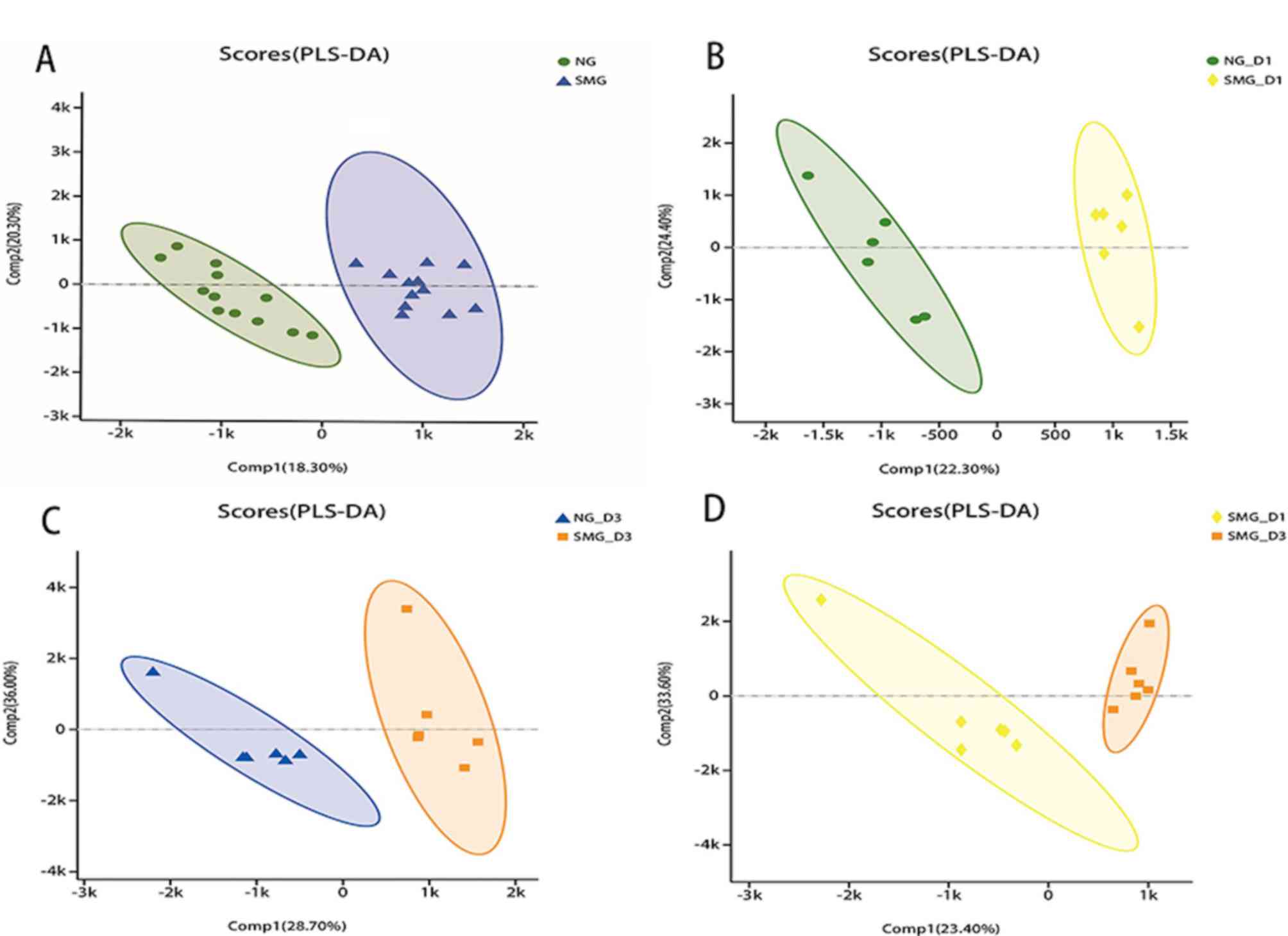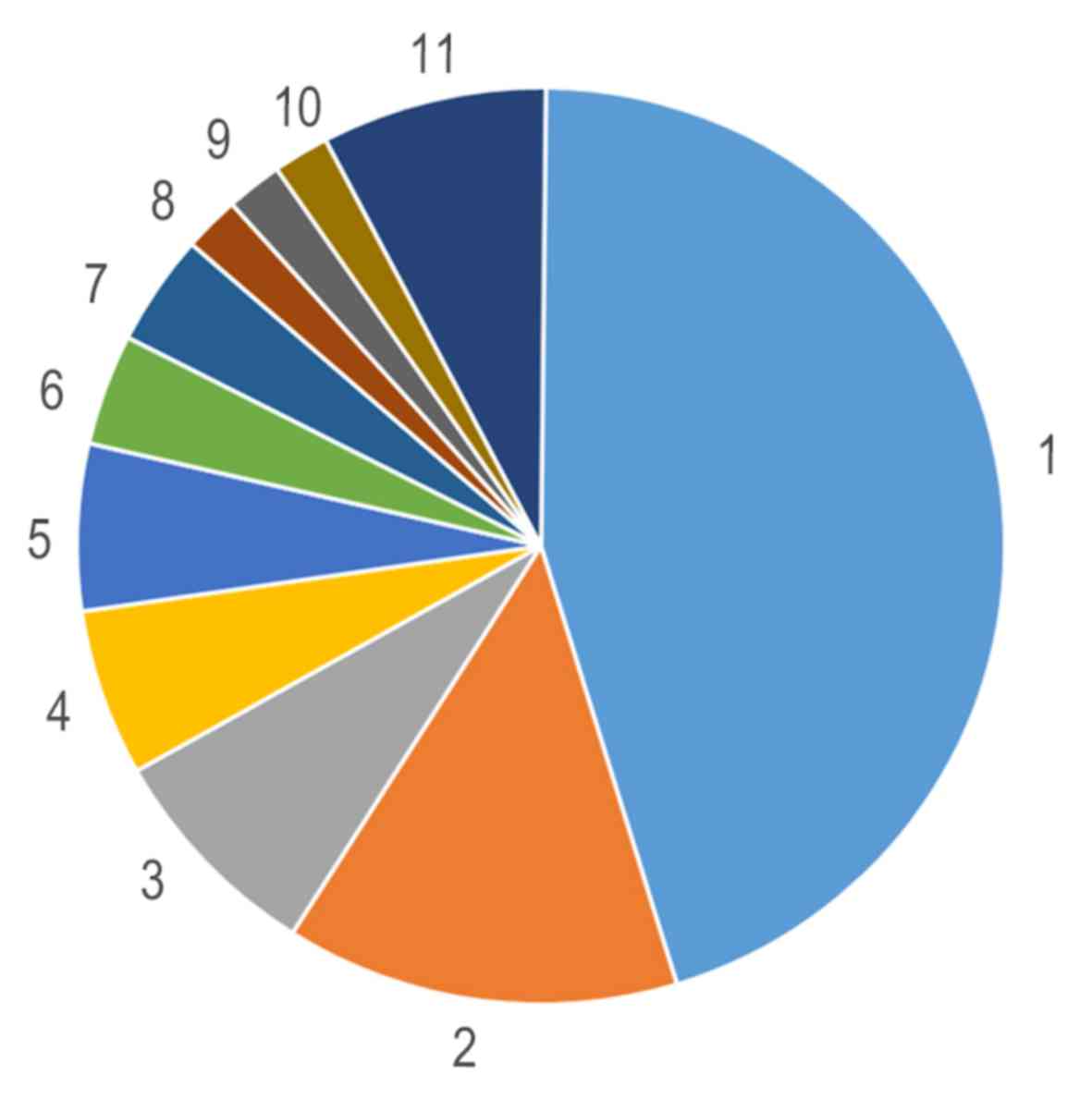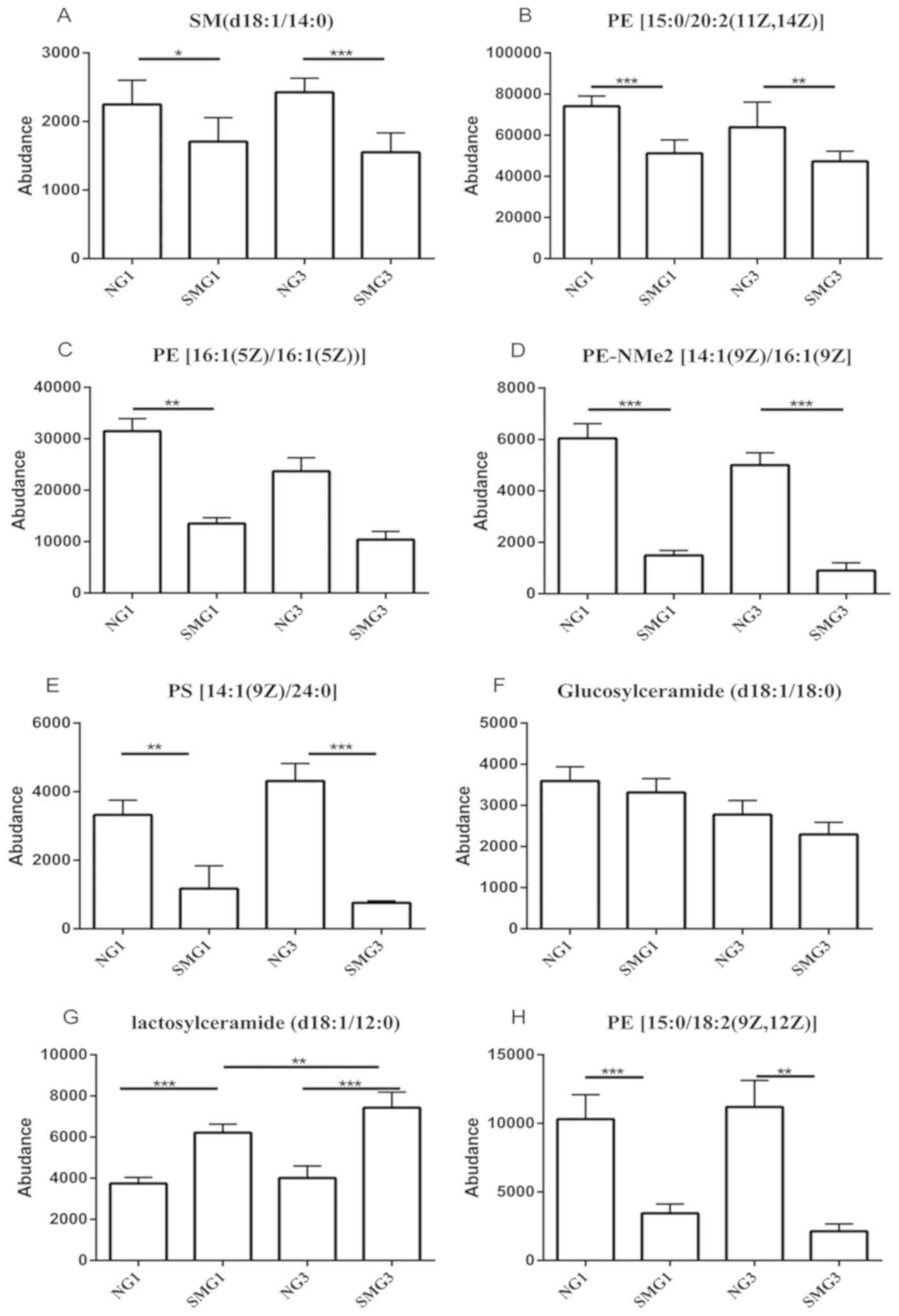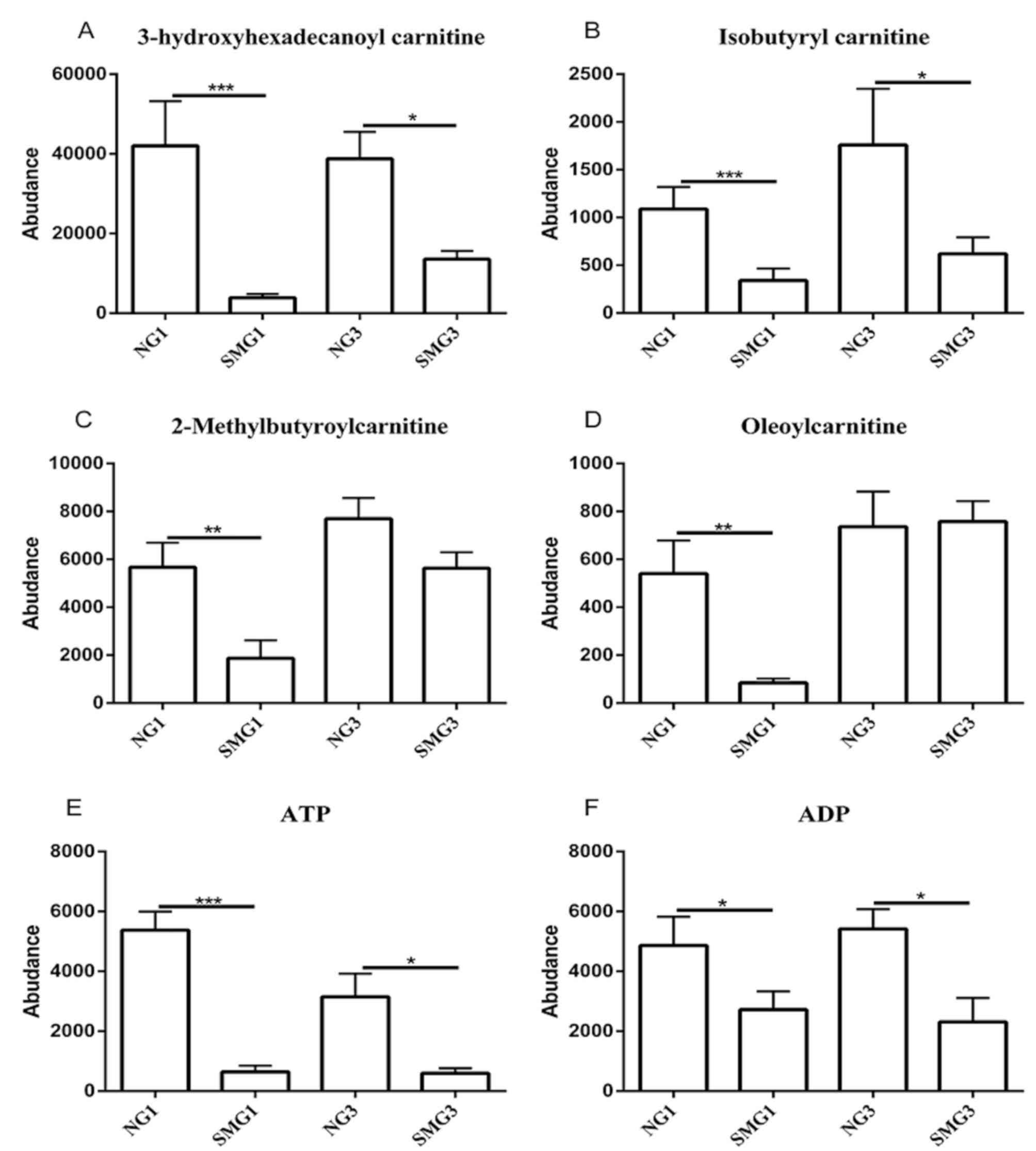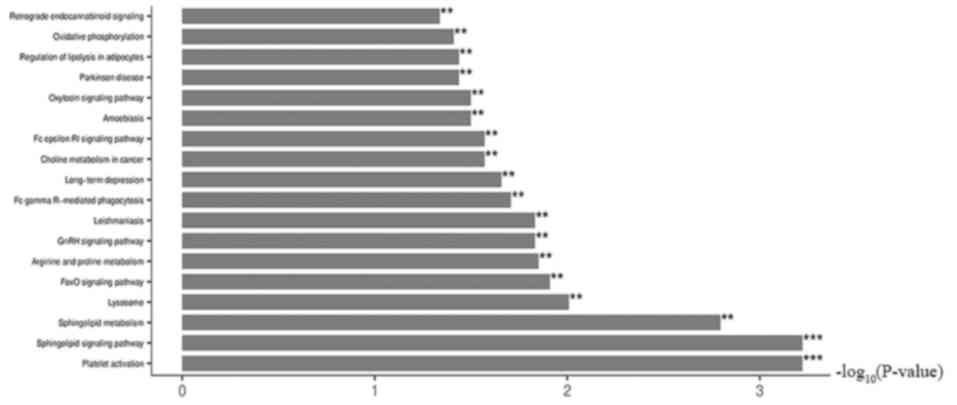|
1
|
Fedotov AA, Akulov SA and Akulova AS:
Alterations in cardiovascular system under artificially simulated
microgravity: Preliminary study. Conf Proc IEEE Eng Med Biol Soc.
2016:204–206. 2016.PubMed/NCBI
|
|
2
|
Atomi Y: Gravitational Effects on human
physiology. Subcell Biochem. 72:627–59. 2015. View Article : Google Scholar : PubMed/NCBI
|
|
3
|
Hughes-Fulford M: Changes in gene
expression and signal transduction in microgravity. J Gravit
Physiol. 8:P1–4. 2001.PubMed/NCBI
|
|
4
|
Ulbrich C, Wehland M, Pietsch J,
Aleshcheva G, Wise P, van Loon J, Magnusson N, Infanger M, Grosse
J, Eilles C, et al: The impact of simulated and real microgravity
on bone cells and mesenchymal stem cells. Biomed Res Int.
2014:9285072014. View Article : Google Scholar : PubMed/NCBI
|
|
5
|
Riwaldt S, Bauer J, Wehland M, Slumstrup
L, Kopp S, Warnke E, Dittrich A, Magnusson NE, Pietsch J, Corydon
TJ, et al: Pathways regulating spheroid formation of human
follicular thyroid cancer cells under simulated microgravity
conditions: A genetic approach. Int J Mol Sci. 17:5282016.
View Article : Google Scholar : PubMed/NCBI
|
|
6
|
Svejgaard B, Wehland M, Ma X, Kopp S,
Sahana J, Warnke E, Aleshcheva G, Hemmersbach R, Hauslage J, Grosse
J, et al: Common effects on cancer cells exerted by a
randompositioning machine and a 2D clinostat. PLoS One.
10:e01351572015. View Article : Google Scholar : PubMed/NCBI
|
|
7
|
Sahana J, Nassef MZ, Wehland M, Kopp S,
Krüger M, Corydon TJ, Infanger M, Bauer J and Grimm D: Decreased
E-cadherin in MCF-7 human breast cancer cells forming multicellular
spheroids exposed to simulated microgravity. Proteomics.
18:e18000152018. View Article : Google Scholar : PubMed/NCBI
|
|
8
|
Vidyasekar P, Shyamsunder P, Arun R,
Santhakumar R, Kapadia NK, Kumar R and Verma RS: Genome wide
expression profiling of cancer cell lines cultured in microgravity
reveals significant dysregulation of cell cycle and MicroRNA gene
networks. PLoS One. 10:e01359582015. View Article : Google Scholar : PubMed/NCBI
|
|
9
|
Dietz C, Infanger M, Romswinkel A, Strube
F and Kraus A: Apoptosis induction and alteration of cell adherence
in human lung cancer cells under simulated microgravity. Int J Mol
Sci. 20(pii): E36012019. View Article : Google Scholar : PubMed/NCBI
|
|
10
|
Kim YJ, Jeong AJ, Kim M, Lee C, Ye SK and
Kim S: Time-averaged simulated microgravity (taSMG) inhibits
proliferation of lymphoma cells, L-540 and HDLM-2, using a 3D
clinostat. Biomed Eng Online. 16:482017. View Article : Google Scholar : PubMed/NCBI
|
|
11
|
Warburg O: On respiratory impairment in
cancer cells. Science. 124:269–272. 1956.PubMed/NCBI
|
|
12
|
Nath S and Villadsen J: Oxidative
phosphorylation revisited. Biotechnol Bioeng. 112:429–437. 2015.
View Article : Google Scholar : PubMed/NCBI
|
|
13
|
Hanahan D and Weinberg RA: Hallmarks of
cancer: The next generation. Cell. 144:646–74. 2011. View Article : Google Scholar : PubMed/NCBI
|
|
14
|
Hu JD, Tang HQ, Zhang Q, Fan J, Hong J, Gu
JZ and Chen JL: Prediction of gastric cancer metastasis through
urinary metabolomics investigation using GC/MS. World J
Gastroenterol. 17:727–734. 2011. View Article : Google Scholar : PubMed/NCBI
|
|
15
|
Chen JL, Tang HQ, Hu JD, Fan J, Hong J and
Gu JZ: Metabolomics of gastric cancer metastasis detected by gas
chromatography and mass spectrometry. World J Gastroenterol.
16:5874–5880. 2010. View Article : Google Scholar : PubMed/NCBI
|
|
16
|
Gatenby RA and Gillies RJ: Why do cancers
have high aerobic glycolysis. Nat Rev Cancer. 4:891–899. 2004.
View Article : Google Scholar : PubMed/NCBI
|
|
17
|
Koukourakis MI, Pitiakoudis M,
Giatromanolaki A, Tsarouha A, Polychronidis A, Sivridis E and
Simopoulos C: Oxygen and glucose consumption in gastrointestinal
adenocarcinomas: Correlation with markers of hypoxia, acidity and
anaerobic glycolysis. Cancer Sci. 97:1056–1060. 2006. View Article : Google Scholar : PubMed/NCBI
|
|
18
|
Pedersen PL, Mathupala S, Rempel A,
Geschwind JF and Ko YH: A key player in the growth and survival of
many cancers and an ideal prospect for therapeutic intervention.
Biochim Biophys Acta. 1555:14–20. 2002. View Article : Google Scholar : PubMed/NCBI
|
|
19
|
Tech K, Tikunov AP, Farooq H, Morrissy AS,
Meidinger J, Fish T, Green SC, Liu H, Li Y, Mungall AJ, et al:
Pyruvate kinase inhibits proliferation during postnatal cerebellar
neurogenesis and suppresses medulloblastoma formation. Cancer Res.
77:3217–3230. 2017. View Article : Google Scholar : PubMed/NCBI
|
|
20
|
An J, Zhang Y, He J, Zang Z, Zhou Z, Pei
X, Zheng X, Zhang W, Yang H and Li S: Lactate dehydrogenase A
promotes the invasion and proliferation of pituitary adenoma. Sci
Rep. 7:47342017. View Article : Google Scholar : PubMed/NCBI
|
|
21
|
Israelsen WJ and Vander Heiden MG:
Pyruvate kinase: Function, regulation and role in cancer. Semin
Cell Dev Biol. 43:43–51. 2015. View Article : Google Scholar : PubMed/NCBI
|
|
22
|
Wu J, Hu L, Chen M, Cao W, Chen H and He
T: Pyruvate kinase M2 overexpression and poor prognosis in solid
tumors of digestive system: Evidence from 16 cohort studies. Onco
Targets Ther. 9:4277–4288. 2016. View Article : Google Scholar : PubMed/NCBI
|
|
23
|
Jové M, Collado R, Quiles JL,
Ramírez-Tortosa MC, Sol J, Ruiz-Sanjuan M, Fernandez M, de la Torre
Cabrera C, Ramírez-Tortosa C, Granados-Principal S, et al: A plasma
metabolomic signature discloses human breast cancer. Oncotarget.
8:19522–19533. 2017. View Article : Google Scholar : PubMed/NCBI
|
|
24
|
Pandey R, Caflisch L, Lodi A1, Brenner AJ
and Tiziani S: Metabolomic signature of brain cancer. Mol Carcinog.
56:2355–2371. 2017. View Article : Google Scholar : PubMed/NCBI
|
|
25
|
Navas-Carrillo D, Rodriguez JM,
Montoro-García S and Orenes-Piñero E: High-resolution proteomics
and metabolomics in thyroid cancer: Deciphering novel biomarkers.
Crit Rev Clin Lab Sci. 54:446–457. 2017. View Article : Google Scholar : PubMed/NCBI
|
|
26
|
Chen L, Yang X, Cui X, Jiang MM, Gui Y,
Zhang YN and Luo XD: Adrenomedullin is a key protein mediating
rotary cell culture system that induces the effects of simulated
microgravity on human breast cancer Cells. Microgravity Sci
Technol. 27:417–426. 2015. View Article : Google Scholar
|
|
27
|
Michaletti A, Gioia M, Tarantino U and
Zolla L: Effects of microgravity on osteoblast mitochondria: A
proteomic and metabolomics profile. Sci Rep. 7:153762017.
View Article : Google Scholar : PubMed/NCBI
|
|
28
|
Morabito C, Steimberg N, Mazzoleni G,
Guarnieri S, Fanò-Illic G and Mariggiò MA: RCCS bioreactor-based
modelled microgravity induces significant changes on in vitro 3D
neuroglial cell cultures. Biomed Res Int. 2015:7542832015.
View Article : Google Scholar : PubMed/NCBI
|
|
29
|
Longo N, Frigeni M and Pasquali M:
Carnitine transport and fatty acid oxidation. Biochim Biophys Acta.
1863:2422–2435. 2016. View Article : Google Scholar : PubMed/NCBI
|
|
30
|
Pietsch J, Ma X, Wehland M, Aleshcheva G,
Schwarzwälder A, Segerer J, Birlem M, Horn A, Bauer J, Infanger M
and Grimm D: Spheroid formation of human thyroid cancer cells in an
automated culturing system during the Shenzhou-8 Space mission.
Biomaterials. 34:7694–705. 2013. View Article : Google Scholar : PubMed/NCBI
|
|
31
|
Riwaldt S, Pietsch J, Sickmann A, Bauer J,
Braun M, Segerer J, Schwarzwälder A, Aleshcheva G, Corydon TJ,
Infanger M and Grimm D: Identification of proteins involved in
inhibition of spheroid formation under microgravity. Proteomics.
15:2945–2952. 2015. View Article : Google Scholar : PubMed/NCBI
|
|
32
|
Arun RP, Sivanesan D, Vidyasekar P and
Verma RS: PTEN/FOXO3/AKT pathway regulates cell death and mediates
morphogenetic differentiation of Colorectal Cancer Cells under
Simulated Microgravity. Sci Rep. 7:59522017. View Article : Google Scholar : PubMed/NCBI
|
|
33
|
Kopp S, Sahana J, Islam T, Petersen AG,
Bauer J, Corydon TJ, Schulz H, Saar K, Huebner N, Slumstrup L, et
al: The role of NFκB in spheroid formation of human breast cancer
cells cultured on the random positioning machine. Sci Rep.
8:9212018. View Article : Google Scholar : PubMed/NCBI
|
|
34
|
Chen ZY, Guo S, Li BB, Jiang N, Li A, Yan
HF, Yang HM, Zhou JL, Li CL and Cui Y: Effect of weightlessness on
the 3D structure formation and physiologic function of human cancer
cells. Biomed Res Int. 2019:48940832019.PubMed/NCBI
|
|
35
|
Marín de Mas I, Aguilar E, Jayaraman A,
Polat IH, Martín-Bernabé A, Bharat R, Foguet C, Milà E, Papp B,
Centelles JJ and Cascante M: Cancer cell metabolism as new targets
for novel designed therapies. Future Med Chem. 6:1791–1810. 2014.
View Article : Google Scholar : PubMed/NCBI
|
|
36
|
Zhu M, Jin XW, Wu BY, Nie JL and Li YH:
Effects of simulated weightlessness on cellular morphology and
biological characteristics of cell lines SGC-7901 and HFE-145.
Genet Mol Res. 13:6060–6069. 2014. View Article : Google Scholar : PubMed/NCBI
|
|
37
|
Espinosa-Jeffrey A, Nguyen K, Kumar S,
Toshimasa O, Hirose R, Reue K, Vergnes L, Kinchen J and Vellis J:
Simulated microgravity enhances oligodendrocyte mitochondrial
function and lipid metabolism. J Neurosci Res. 94:1434–1450. 2016.
View Article : Google Scholar : PubMed/NCBI
|
|
38
|
Akagi T and Kimoto T: Human cell line
(HGC-27) derived from the metastatic lymph node of gastric cancer.
Acta Med Okayama. 30:215–219. 1976.PubMed/NCBI
|
|
39
|
Kawakami H, Zaanan A and Sinicrope FA:
Microsatellite instability testing and its role in the management
of colorectal cancer. Curr Treat Options Oncol. 16:302015.
View Article : Google Scholar : PubMed/NCBI
|
|
40
|
Zalba S and Ten Hagen TL: Cell membrane
modulation as adjuvant in cancer therapy. Cancer Treat Rev.
52:48–57. 2017. View Article : Google Scholar : PubMed/NCBI
|
|
41
|
Kim HY, Lee KM, Kim SH, Kwon YJ, Chun YJ
and Choi HK: Comparative metabolic and lipidomic profiling of human
breast cancer cells with different metastatic potentials.
Oncotarget. 7:67111–67128. 2016.PubMed/NCBI
|
|
42
|
Elvas F, Stroobants S and Wyffels L:
Phosphatidylethanolamine targeting for cell death imaging in early
treatment response evaluation and disease diagnosis. Apoptosis.
22:971–987. 2017. View Article : Google Scholar : PubMed/NCBI
|
|
43
|
Iorio E, Ricci A, Bagnoli M, Pisanu ME,
Castellano G, Di Vito M, Venturini E, Glunde K, Bhujwalla ZM,
Mezzanzanica D, et al: Activation of phosphatidylcholine cycle
enzymes in human epithelial ovarian cancer cells. Cancer Res.
70:2126–2135. 2010. View Article : Google Scholar : PubMed/NCBI
|
|
44
|
Grimm D, Bauer J, Kossmehl P, Shakibaei M,
Schöberger J, Pickenhahn H, Schulze-Tanzil G, Vetter R, Eilles C,
Paul M and Cogoli A: Simulated microgravity alters differentiation
and increases apoptosis in human follicular thyroid carcinoma
cells. FASEB J. 16:604–606. 2002. View Article : Google Scholar : PubMed/NCBI
|
|
45
|
Kossmehl P, Shakibaei M, Cogoli A,
Infanger M, Curcio F, Schönberger J, Eilles C, Bauer J, Pickenhahn
H, Schulze-Tanzil G, et al: Weightlessness induced apoptosis in
normal thyroid cells and papillary thyroid carcinoma cells via
extrinsic and intrinsic pathways. Endocrinology. 144:4172–4179.
2003. View Article : Google Scholar : PubMed/NCBI
|
|
46
|
Masiello MG, Cucina A, Proietti S, Palombo
A, Coluccia P, D'Anselmi F, Dinicola S, Pasqualato A, Morini V and
Bizzarri M: Phenotypic switch induced by simulated microgravity on
MDA-MB-231 breast cancer cells. Biomed Res Int. 2014:6524342014.
View Article : Google Scholar : PubMed/NCBI
|
|
47
|
Zhao J, Ma H, Wu L, Cao L, Yang Q, Dong H,
Wang Z, Ma J and Li Z: The influence of simulated microgravity on
proliferation and apoptosis in U251 glioma cells. In Vitro Cell Dev
Biol Anim. 53:744–751. 2017. View Article : Google Scholar : PubMed/NCBI
|
|
48
|
Paulick MG and Bertozzi CR: The
glycosylphosphatidylinositol anchor: a complex membrane-anchoring
structure for protein. Biochemistry. 47:6991–7000. 2008. View Article : Google Scholar : PubMed/NCBI
|
|
49
|
Ferguson MA, Homans SW, Dwek RA and
Rademacher TW: Glycosyl-phosphatidylinositol moiety that anchors
Trypanosoma brucei variant surface glycoprotein to the membrane.
Science. 239:753–759. 1988. View Article : Google Scholar : PubMed/NCBI
|
|
50
|
Ferguson MA: The structure, biosynthesis
and functions of glycosylphosphatidylinositol anchors, and the
contributions of trypanosome research. J Cell Sci. 112:2799–2809.
1999.PubMed/NCBI
|
|
51
|
Tsai YH, Liu X and Seeberger PH: Chemical
biology of glycosylphosphatidylinositol anchors. Angew Chem Int Ed
Engl. 51:11438–11456. 2012. View Article : Google Scholar : PubMed/NCBI
|
|
52
|
Chang D, Xu H, Guo Y, Jiang X, Liu Y, Li
K, Pan C, Yuan M, Wang J, Li T and Liu C: Simulated microgravity
alters the metastatic potential of a human lung adenocarcinoma cell
line. In Vitro Cell Dev Biol Anim. 49:170–177. 2019. View Article : Google Scholar
|
|
53
|
Qian A, Zhang W, Xie L, Weng Y, Yang P,
Wang Z, Hu L, Xu HY, Tian ZC and Shang P: Simulated weightlessness
alters biological characteristics of human breast cancer cell line
MCF-7. Acta Astronautica. 63:947–958. 2008. View Article : Google Scholar
|
|
54
|
Peng W, Tan S, Xu Y, Wang L, Qiu D, Cheng
C, Lin Y, Liu C, Li Z, Li Y, et al: LC-MS/MS metabolome analysis
detects the changes in the lipid metabolic profiles of dMMR and
pMMR cells. Oncol Rep. 40:1026–1034. 2018.PubMed/NCBI
|
|
55
|
Toshima K, Nagafuku M, Okazaki T,
Kobayashi T and Inokuchi JI: Plasma membrane sphingomyelin
modulates thymocyte development by inhibiting TCR-induced
apoptosis. Int Immunol. 31:211–223. 2019. View Article : Google Scholar : PubMed/NCBI
|
|
56
|
Hogan PG: Sphingomyelin, ORAI1 channels,
and cellular Ca2+ signaling. J Gen Physiol. 146:195–200. 2015.
View Article : Google Scholar : PubMed/NCBI
|
|
57
|
Matanes F, Twal WO and Hammad SM:
Sphingolipids as biomarkers of disease. Adv Exp Med Biol.
1159:109–138. 2019. View Article : Google Scholar : PubMed/NCBI
|
|
58
|
Kohama T, Olivera A, Edsall L, Nagiec MM,
Dickson R and Spiegel S: Molecular cloning and functional
characterization of murine sphingosine kinase. J Biol Chem.
273:23722–23728. 1998. View Article : Google Scholar : PubMed/NCBI
|
|
59
|
Li J, Gray BD, Pak KY and Ng CK: Targeting
phosphatidylethanolamine and phosphatidylserine for imaging
apoptosis in cancer. Nucl Med Biol. 78:23–30. 2019. View Article : Google Scholar : PubMed/NCBI
|
|
60
|
Andrieu-Abadie N and Levade T:
Sphingomyelin hydrolysis during apoptosis. Biochim Biophys Acta.
1585:126–134. 2002. View Article : Google Scholar : PubMed/NCBI
|
|
61
|
van der Hoeven D, Cho KJ, Zhou Y, Ma X,
Chen W, Naji A, Montufar-Solis D, Zuo Y, Kovar SE, Levental KR, et
al: Sphingomyelin metabolism is a regulator of K-Ras function. Mol
Cell Biol. 38(pii): e00373–17. 2018.PubMed/NCBI
|
|
62
|
Fernández-Medarde A and Santos E: Ras in
cancer and developmental diseases. Genes Cancer. 2:344–358. 2011.
View Article : Google Scholar : PubMed/NCBI
|
|
63
|
Cacev T, Radosević S, Spaventi R, Pavelić
K and Kapitanović S: NF1 gene loss of heterozygosity and expression
analysis in sporadic colon cancer. Gut. 54:1129–1135. 2005.
View Article : Google Scholar : PubMed/NCBI
|
|
64
|
Dhomen N and Marais R: New insight into
BRAF mutations in cancer. Curr Opin Genet Dev. 17:31–39. 2007.
View Article : Google Scholar : PubMed/NCBI
|
|
65
|
Khoukaz T: Administration of anti-EGFR
therapy: A practical review. Semin Oncol Nurs. 22:20–27. 2006.
View Article : Google Scholar : PubMed/NCBI
|
|
66
|
Baek MO, Ahn CB, Cho HJ, Choi JY, Son KH
and Yoon MS: Simulated microgravity inhibits C2C12 myogenesis via
phospholipase D2-induced Akt/FOXO1 regulation. Sci Rep.
9:149102019. View Article : Google Scholar : PubMed/NCBI
|
|
67
|
Wang Z, Zhang F, He J, Wu P, Tay LWR, Cai
M, Nian W, Weng Y, Qin L, Chang JT, et al: Binding of
PLD2-generated phosphatidic acid to KIF5B promotes MT1-MMP surface
trafficking and lung metastasis of mouse breast cancer cells. Dev
Cell. 43:186–197. 2017. View Article : Google Scholar : PubMed/NCBI
|
|
68
|
Zeiller C, Mebarek S, Jaafar R, Pirola L,
Lagarde M, Prigent AF and Némoz G: Phospholipase D2 regulates
endothelial permeability through cytoskeleton reorganization and
occludin downregulation. Biochim Biophys Acta. 1793:1236–1249.
2009. View Article : Google Scholar : PubMed/NCBI
|
|
69
|
Ngo Thai Bich V, Hongu T, Miura Y,
Katagiri N, Ohbayashi N, Yamashita-Kanemaru Y, Shibuya A, Funakoshi
Y and Kanaho Y: Physiological function of phospholipase D2 in
anti-tumor immunity: Regulation of CD8+ T lymphocyte proliferation.
Sci Rep. 8:62832018. View Article : Google Scholar : PubMed/NCBI
|
|
70
|
Kandori S, Kojima T, Matsuoka T, Yoshino
T, Sugiyama A, Nakamura E, Shimazui T, Funakoshi Y, Kanaho Y and
Nishiyama H: Phospholipase D2 promotes disease progression of renal
cell carcinoma through the induction of angiogenin. Cancer Sci.
109:1865–1875. 2018. View Article : Google Scholar : PubMed/NCBI
|
|
71
|
Guo L, Cui C, Zhang K, Wang J, Wang Y, Lu
Y, Chen K, Yuan J, Xiao G, Tang B, et al: Kindlin-2 links
mechano-environment to proline synthesis and tumor growth. Nat
Commun. 10:8452019. View Article : Google Scholar : PubMed/NCBI
|
|
72
|
Phang JM, Donald SP, Pandhare J and Liu Y:
The metabolism of proline, a stress substrate, modulates
carcinogenic pathways. Amino Acids. 35:681–690. 2008. View Article : Google Scholar : PubMed/NCBI
|
|
73
|
Liu W, Wang X, Liu Z, Wang Y, Yin B, Yu P,
Duan X, Liao Z, Chen Y, Liu C, et al: SGK1 inhibition induces
autophagy-dependent apoptosis via the mTOR-Foxo3a pathway. Br J
Cancer. 117:1139–1153. 2017. View Article : Google Scholar : PubMed/NCBI
|
|
74
|
Wallimann T, Tokarska-Schlattner M and
Schlattner U: The creatine kinase system and pleiotropic effects of
creatine. Amino Acids. 40:1271–1296. 2011. View Article : Google Scholar : PubMed/NCBI
|
|
75
|
Campos-Ferraz PL, Gualano B, das Neves W,
Andrade IT, Hangai I, Pereira RT, Bezerra RN, Deminice R,
Seelaender M and Lancha AH: Exploratory studies of the potential
anti-cancer effects of creatine. Amino Acids. 48:1993–2001. 2016.
View Article : Google Scholar : PubMed/NCBI
|
|
76
|
Martin KJ, Chen SF, Clark GM, Degen D,
Wajima M, Von Hoff DD and Kaddurah-Daouk R: Evaluation of creatine
analogs as a new class of anticancer agents using freshly explanted
human tumor cells. J Natl Cancer Inst. 86:608–613. 1994. View Article : Google Scholar : PubMed/NCBI
|
|
77
|
Miller EE, Evans AE and Cohn M: Inhibition
of rate of tumor growth by creatine and cyclocreatine. Proc Natl
Acad Sci USA. 90:3304–3308. 1993. View Article : Google Scholar : PubMed/NCBI
|
|
78
|
Hoppeler H and Fluck M: Plasticity of
skeletal muscle mitochondria: Structure and function. Med Sci
Sports Exerc. 35:95–104. 2003. View Article : Google Scholar : PubMed/NCBI
|
|
79
|
Adams SH, Hoppel CL, Lok KH, Zhao L, Wong
SW, Minkler PE, Hwang DH, Newman JW and Garvey WT: Plasma
acylcarnitine profiles suggest incomplete long-chain fatty acid
beta-oxidation and altered tricarboxylic acid cycle activity in
type 2 diabetic African-American women. J Nutr. 139:1073–1081.
2009. View Article : Google Scholar : PubMed/NCBI
|
|
80
|
Chen WW, Freinkman E, Wang T, Birsoy K and
Sabatini DM: Absolute quantification of matrix metabolites reveals
the dynamics of mitochondrial metabolism. Cell. 166:1324–1337.
2016. View Article : Google Scholar : PubMed/NCBI
|
|
81
|
Hutschenreuther A, Birkenmeier G, Bigl M,
Krohn K and Birkemeyer C: Glycerophosphoglycerol, Beta-alanine, and
pantothenic acid as metabolic companions of glycolytic activity and
cell migration in breast cancer cell lines. Metabolites.
3:1084–1101. 2013. View Article : Google Scholar : PubMed/NCBI
|
|
82
|
Leonardi R and Jackowski S: Biosynthesis
of pantothenic acid and coenzyme A. EcoSal Plus. 2:2007. View Article : Google Scholar : PubMed/NCBI
|
|
83
|
Vurusaner B, Poli G and Basaga H: Tumor
suppressor genes and ROS: Complex networks of interactions. Free
Radic Biol Med. 52:7–18. 2012. View Article : Google Scholar : PubMed/NCBI
|
|
84
|
Gomes AR, Brosens JJ and Lam EW: Resist or
die: FOXO transcription factors determine the cellular response to
chemotherapy. Cell Cycle. 7:3133–3136. 2008. View Article : Google Scholar : PubMed/NCBI
|
|
85
|
Hou YQ, Yao Y, Bao YL, Song ZB, Yang C,
Gao XL, Zhang WJ, Sun LG, Yu CL, Huang YX, et al: Juglanthraquinone
C induces intracellular ROS increase and apoptosis by activating
the Akt/Foxo signal pathway in HCC cells. Oxid Med Cell Longev.
2016:49416232016. View Article : Google Scholar : PubMed/NCBI
|
|
86
|
Maiese K, Chong ZZ, Hou J and Shang YC:
Erythropoietin and oxidative stress. Curr Neurovasc Res. 5:125–142.
2008. View Article : Google Scholar : PubMed/NCBI
|
|
87
|
Nakamura T and Sakamoto K: Forkhead
transcription factor FOXO subfamily is essential for reactive
oxygen species-induced apoptosis. Mol Cell Endocrinol. 281:47–55.
2008. View Article : Google Scholar : PubMed/NCBI
|
|
88
|
Barthélémy C, Henderson CE and Pettmann B:
Foxo3a induces motoneuron death through the Fas pathway in
cooperation with JNK. BMC Neurosci. 5(48)2004.
|
|
89
|
Maiese K, Chong ZZ, Li F and Shang YC:
Erythropoietin: Elucidating new cellular targets that broaden
therapeutic strategies. Prog Neurobiol. 85:194–213. 2008.
View Article : Google Scholar : PubMed/NCBI
|
|
90
|
Nowak K, Killmer K, Gessner C and Lutz W:
E2F-1 regulates expression of FOXO1 and FOXO3a. Biochim Biophys
Acta. 1769:244–252. 2007. View Article : Google Scholar : PubMed/NCBI
|
|
91
|
Liu Y, Ao X, Ding W, Ponnusamy M, Wu W,
Hao X, Yu W, Wang Y, Li P and Wang J: Critical role of FOXO3a in
carcinogenesis. Mol Cancer. 17:1042018. View Article : Google Scholar : PubMed/NCBI
|















